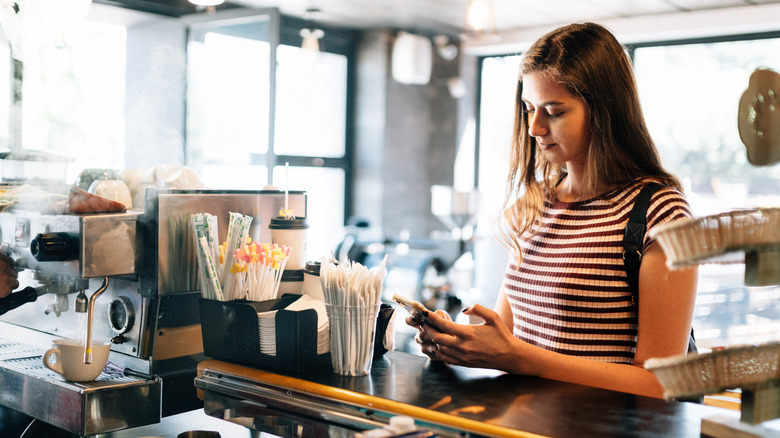The Popular Type Of Coffee Tourists Will Struggle To Find In New Zealand
Beyond its mythical Lord of the Rings-esque landscapes and adventurous nature-bound activities, New Zealand is actually one of the most coffee-loving countries in the world. In fact, its capital, Wellington, has more cafés per capita than NYC, and of New Zealand's 5 million people, 66% drink coffee regularly. The bean reigns supreme in New Zealand, but some coffee aficionados might be surprised to discover that one ubiquitous brew is not on the menu: drip coffee. Also known as filter coffee, drip is immensely popular worldwide, especially in North America and some parts of Europe. It's a no-fuss cup of joe with a straightforward brewing method: hot water passes through ground coffee beans and a filter. Many people love it for its convenience, ease of preparation, and the ability to make large quantities at once (hence the bottomless coffees at American diners).
In contrast, classic espresso-based drinks dominate New Zealand's coffee scene. This goes back to the country's coffee history, which arrived with the first European settlers. However, New Zealand took some time to embrace the bean. It wasn't until the 1980s that it became a part of Kiwi life due to inspiration from Italian coffee culture and widespread, easier access to high-quality espresso machines. Espresso, the base for most popular coffee drinks, is made by forcing hot water through finely ground coffee under very high pressure. This method produces a rich, concentrated shot of coffee with a layer of crema that is the foundation for beverages like lattes, cappuccinos, and flat white.
What a drip: No filter coffee in New Zealand
One of the reasons drip coffee is nearly impossible to find in New Zealand is the country's strong preference for flat white. This drink, which originated in either New Zealand or Australia (the caffeine-fueled debate continues), has become an international sensation. A flat white is made with a shot of espresso topped with microfoam — steamed milk with fine, velvety bubbles. The result is a smooth, creamy coffee with a strong espresso flavor, distinct from the frothier cappuccino or the milkier latte. The flat white's popularity has influenced the local coffee culture significantly as the default drink of choice. The rich flavors of espresso-based drinks have left little room on the Kiwi menu for the more diluted taste of drip coffee.
Another factor is the widespread availability of high-quality espresso machines. Even in the smallest cafés, you're likely to find a state-of-the-art machine operated by a barista who looks like they know what they're doing. A doctor's office, gas station, and liquor store? Yes, all likely to have their own fancy machine percolating, as well. Conversely, drip coffee makers in cafés, or elsewhere for that matter, are rare. In Kiwi homes, most locals have a French press or an espresso machine. Moreover, contrary to North America and Europe, to-go coffee in disposable cups is not really a thing — at least, not the right thing to do. Customers are encouraged to bring their own reusable cups or have their coffee "for here."
Adapting to Kiwi coffee culture
For tourists used to starting their day with a cup of drip coffee, finding it in New Zealand will be a challenge. Major cities like Auckland and Wellington have a few cafés that cater to international tastes and may offer drip coffee, but they are the exceptions rather than the rule. Starbucks is the safest bet with its classic filter coffees (like it has everywhere else in the world). In smaller towns or rural areas, the chances of finding drip coffee are even slimmer.
Instead of the futile quest for a cup of drip, try to embrace the local coffee culture. Order a long black (a shot of espresso poured over a bit of hot water — preserves the crema) or the more straightforward americano (extra hot water poured over a shot of espresso — see the difference?). These drinks can be a delightful way to experience New Zealand coffee while not veering too far from the essence of drip coffee. Some cafés also offer pour-over or Chemex coffee.
If you're feeling experimental and want to expand your coffee horizons, why not try a macchiato, doppio, or the iconic flat white? Plus, the local cafés tend to have welcoming atmospheres and skilled baristas who are passionate about their craft and happy to help you. Adapting to New Zealand's espresso-first culture might require some flexibility, but it will make for a rewarding and caffeinated travel experience. You might just fall in love and never drink drip coffee again!


